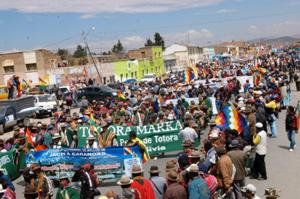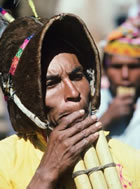|
|
|
People
Population
Estimated to be 10.2 million in 2009. The most recent available national census (2001) measured the population at 8.3 million.
The annual population growth rate was estimated at 1.56% in 2004.
The population is notable for its great cultural diversity, due to the existence of more than fifty different ethnic groups. In the 2001 census 62% of Bolivians (over the age of 15) identified themselves as indigenous.
Indigenous groups
Quechua (30%), Aymara (25%), Guarani (1.5%), Chiquitano (2.2%), Mojeno (0.85%), Other indigenous (1.5%). 36 groups in all.
Languages
As well as Spanish, Bolivia's official languages are: Aymara, Araona, Baure, Bésiro, Canichana, Cavineño, Cayubaba, Chácobo, Chimán, Ese Ejja, Guaraní, Guarasuawe, Guarayu, Itonama, Leco, Machajuyai-Kallawaya, Machineri, Maropa, Mojeño-trinitario, Mojeño-Ignaciano, Moré, Mosetén, Movima, Pacawara, Puquina, Quechua, Sirionó, Tacana, Tapiete, Toromona, Uruchipaya, Weenhayek, Yaminawa, Yuki, Yuracaré and Zamuco.
Indigenous peoples
Bolivia has the largest proportion of indigenous people in Latin America, with 62% of the total population of Bolivia considering themselves to be of indigenous descent This compares with about 50% in Guatemala, 40% in Peru and 35% in Ecuador. The indigenous Quechua and Aymara groups make up the great majority of the population in the northern parts of the Altiplano, and in the higher valleys and basins of the Andes. The Chiquitanos and Guarani-speaking peoples of the eastern lowlands are the third and fourth most numerous ethnic groups. There is a wide variety of small lowland indigenous groupings in the departments of Santa Cruz, the Beni and Pando.
Many of the indigenous languages and ways of life have been maintained as indigenous people represent such a large proportion of Bolivia’s population. Indigenous practices and customs are also reflected in Bolivian popular culture. Although Spanish tends to predominate in urban areas, more than half of the population has an indigenous language as their mother tongue. Community festivals, which continue to play a significant role in rural cultural life, are also still important in those cities with large indigenous populations.
Historically, at the end of the Spanish colonial period, Bolivia's principal ethnic groups were a majority of Quechua or Aymara indigenous people, a small number of European-descended whites and a larger and more diverse group of mestizos. Political and economic power was largely monopolised by the latter two groups. The term 'cholo', which is still in use, was generally adopted to describe an indigenous person considered to be attempting upward mobility through assimilation: taking on the norms and cultural and linguistic identity of a mestizo.
Bolivia was also a home to a number of other minority groups. The Callahuaya, for example, are a linguistically distinct sub-group of the Aymara who lived in the Muñecas and Franz Tamayo provinces of the Department of La Paz. Widely known for their folk medicine practices, most Callahuaya men earned a living travelling among the markets throughout the Andes, speaking either Quechua, Aymara, or Spanish in addition to their native Callahuaya.
There is also a small black population in Bolivia concentrated in the Nor and Sur Yungas regions in the department of La Paz. These communities are descended from Africans, brought to Bolivia as slave labour for the mines before the Spaniards concluded that the slaves were 'unsuitable' to work in the horrific prevailing conditions.
Significant numbers of Europeans later migrated to Bolivia, most immediately before and during World War II. In the years preceding World War II, Jewish people found refuge in Bolivia. In the years afterwards, Nazi sympathisers did likewise. Probably the most notorious was Klaus Barbie, the infamous Gestapo 'butcher of Lyon'. The opening up of Santa Cruz also attracted large numbers of Europeans, particularly from Eastern Europe and the former Yugoslavia. There are also colonies of Japanese and Mennonite farmers in northern Santa Cruz. Attempts to resettle anti-Communist Vietnamese refugees and South African white farmers in Santa Cruz were aborted after objections were raised.
Religion
Roman Catholic approx. 95%, with syncretism in indigenous communities.
Protestant approx. 5% (growing); mostly Evangelical or Methodist.
Following the implementation the new constitution in 2009 Bolivia is now officially a secular state. However Roman Catholic Christianity remains, at least nominally, the religion of the vast majority of the population. The Catholic Church is a key political institution and for many years liberation theology was an important influence. It has played an important role in mediating political disputes over the last thirty years, though over recent years, has begun to take a more conservative stance.
Catholicism is often syncretised with indigenous beliefs in predominantly indigenous communities. The Spanish colonial period and its aftermath failed to suppress such beliefs, and religious practices continue to include many pre-Columbian elements.
As elsewhere in Latin America, the appeal of evangelical churches has grown rapidly in recent years. Many are supported by missionary activities from outside Bolivia, especially from the United States. Their political orientation tends to be conservative.
Patterns of settlement
Bolivia's settlement patterns have been largely determined by the country's distinctive topography and ecology. Similarly, its ecology and terrain have profoundly influenced the relations among the country's diverse groups. The isolation of most communities and regions until at least the 1950s contributed to the preservation of cultural diversity.
Bolivia's population was historically concentrated on the Altiplano, the high plateau contained between two ranges of the Andes Mountains which makes up a third of the country. The population of the inter-Andean valleys is largely concentrated in the areas in and around the cities of Cochabamba, Sucre, and Tarija. This area is traditionally the country's main bread basket. However, the opening up of semi-tropical and tropical parts of the country has led to massive migration to those areas over the last 50 years. The semi-tropical Yungas region to the north-east of La Paz has long been an area where Aymara-speaking farmers from the Altiplano have resettled. Official colonisation schemes of the 1960s and 1970s also led to the opening up of large areas of tropical Cochabamba and the lowland Santa Cruz to migrants from the Altiplano. The Yungas and the Chapare district of Cochabamba are now Bolivia's main coca-producing areas.
The development of Santa Cruz is associated with the expansion of cash-crop agriculture, cattle-rearing and the oil and gas industries. The department has seen high levels of economic growth since the 1960s. Santa Cruz is now often seen as the 'economic capital' of Bolivia. Its population is a mix of long-established settlers, foreign migrants (mainly European, but also Brazilian and Chilean) and internal migrants from the highlands. The concentration of land tenure, coupled with the effects of inward migration, are causing ongoing problems of land shortage in areas to the south, west and north of the city of Santa Cruz.
The main mining areas in Bolivia are located in the western highlands, mainly in the departments of Potosí, Oruro and La Paz. The closure of many of Bolivia's larger state-owned mines in the years after 1985 has accelerated the process of depopulation in many parts of the highlands. However, there is also significant mining potential in other areas, chiefly in the eastern part of Santa Cruz close to the Brazilian frontier, for example, the Pre-Cambrian shield and the giant Mutún iron ore deposits.
Poverty and the lack of adequate employment opportunities in Bolivia have led to massive migration of Bolivians to other countries. More than a million Bolivians are resident in Argentina, for instance. Many are living as illegal immigrants without documentation. Increasingly large numbers of Bolivians are also going further afield, especially to Spain. The Spanish and British governments (as well as the rest of the EU) have recently introduced visa restrictions for Bolivians.
Class
Patterns of economic exploitation dating from the colonial period led to a rigid system of class distinction that broadly reflected the ethnic make-up of the country. Until the 1950s, economic and political power was in the hands of a small white/mestizo elite. The effects of the Bolivian revolution of 1952 helped destroy the old oligarchy (known in Bolivia as the ' rosca '). The nationalisation of the tin mines ended the primacy of the 'tin barons' (the Patiño, Aramayo and Hochschild families), while the agrarian reform broke up landed estates in the Altiplano and valleys.
The politics of class reflected the new political influence of the Bolivian miners, who struggled with successive governments to maintain their influence in the years after the Revolution. The union movement took its inspiration from the Miners' Federation (FSTMB) which effectively controlled the Central Obrera Boliviana (COB), established in 1953. Trade unionism, or ‘sindicalismo’ in Spanish, also permeated the rural sector following the 1953 agrarian reform. Rural trade unionism was a source of support to successive governments - civilian and military - until the formation of the Confederación Sindical Unica de Trabajadores Campesinos de Bolivia (CSUTCB) in 1979, from when it became an independent, united force.
In spite of the growth of indigenous organisation and consciousness in the last few years, the influence of trade unionism persists in Bolivia today. Indigenous organisations and trade unionism are essentially complementary rather than antagonistic forces. Indigenous organisations often build on the trade union tradition in those parts of the country where it has recently become a particularly potent social force. The MAS, whose grass-roots support is organised in social movements of various types, reflects both influences. President Morales himself comes from a trade union tradition, nurtured in the Chapare by the resettlement there of miners displaced following the mine closures of the late 1980s.
|
|




